Back this week with a new model from a brand that I always enjoy reviewing. This is the new Bonanza Oakridge Tenor.
I always say the same thing about the creations of Pete Mai at USA based Bonanza Ukuleles, and that's that he continually sends things over to me that I think, 'that won't work!' and... erm... they do. They always work very well actually. Unconventional, different, wacky at times, but i've never seen one that I didn't think was a great instrument. More of the same here? Let's see.
The Oakridge is a new line from Pete that uses a similar construction style to some of his other models such as the Homestead and the Oreo, but, Pete being Pete, there had to be something 'different' at play. And this time it's a wood I have never personally played before as these are made from solid oak. Oak... mmm'ok.. a very hard, heavy wood. Does that suit a musical instrument? Well we are about to find out!
SUMMARY VIDEO REVIEW
(Note - before the emails come in, yes, I KNOW there are some oak ukes out there - it's just a very uncommon wood and I am making a point in the video for giggles!)
Like the models I mention above, here Pete has repeated his 'clamshell' design which uses two blocks of wood which are routed out to create two dish shapes with integral bracing in the routing, and then sandwiched together to create a sound box. This was the same concept that when I first saw it I thought 'nope, no way' but it really worked great. Like most other Bonanza models you always get a lot of choice in the build and so it is here. With the Oakridge as well as getting a choice of scales (soprano through to baritone) here you also get a choice of the body depth, either 1.5 inches as is the case here or a thicker 2.25 inch body. Then you also get a choice of how the wood is cut, either quartersawn or plank style (which affects the grain pattern). And you also get a choice of shape, a traditional double bout, a cutaway, a pear shape or this ultra modern looking 'amoeba' shape. I will say, purely subjectively, that the amoeba shape is NOT the one I would choose myself, but this in no way impacts the review score for the simple reason that you have a choice. I know many people love this shape too, i'm just a bit more of a traditionalist!
The bridge follows a common style for Bonanza being a through body style made from black walnut. Sitting in that is his usual Corian (simulated stone) straight topped saddle. Spacing here is 43mm.
The finishing is extremely smooth and yet another area where you get a choice of stain, either 'Early American', 'Golden' or 'Natural'. I'm guessing that this is 'natural' but I could be wrong! You will also spy the oak emblem on the top. No, I am not a fan of etchings, but thankfully this is an option also (and in fact Pete is well known for being able to etch names, messages or what you like on the tops). I'd leave it plain myself as the grain of the wood on this is pretty enough for me. It will certainly have people guessing what it's made from!
Inside is unconventional due to the build, so no linings are needed. You can spy below the integral braces.
The neck is bolted to the body and is made from African mahogany. It's in three pieces and tapers down to a comfortable profile and a roomy 38mm nut (30mm G to A).
That is topped with a black walnut fingerboard with what Pete calls his 'self binding' board (meaning the frets are fitted in slots that don't reach the edges, meaning no sharp fret ends). It comes with 18 of those joined at the 14th which are skinny and tidy. Position dots are inlaid wooden dots fitted at the 5th, 7th, 10th, 12th and 15th, but I find it surprising that he put no side dots on this one, as he usually does. I should note that after this review this instrument is being onward shipped to the UK buyer, so 'maybe' they specced no side dots... (not sure why though!). An odd omission.
Like the saddle, the nut is made of Corian and, helpfully, as on other Bonanza ukes is easily removed if you wanted to adjust the action without doing so at the nut slots themselves (always the better plan if you can). When you see the video you will understand why I raise that point!
The headstock is the usual simple Bonanza affair with a chamfered square top and holds the Bonanza logo etched in the facing of more oak veneer.
The tuners here are sealed gears by Der Jung which are renowned to be good quality (ignore the white stickers on the cover plates, they are meant to be peeled off, but this is not my ukulele so I will leave that to the buyer!). And once again we come back to choice because if you wanted something else on this, Pete could provide that.
Finishing this one off are Seaguar strings with an unwound low G (although you can specify what you like) and a couple of strap buttons. And in this spec / shape / body depth etc the price would come in at round about $374. You'll pay a bit more for a bigger scale or a thicker body and a bit less for smaller scales (you get the picture). I may need to check current prices but I think that makes this one one of the better value Bonanza offerings and possibly cheaper than the current price of the no-frills Homestead. Interesting.
Being a cabinet maker by trade, Pete has a lot of experience working with wood and, naturally, like his other ukuleles the finish and feel of the instrument here is very good indeed. Yes you may spy one or two natural marks in the wood or one or two tooling marks, but this is hand made from natural materials. And if you were thinking oak would be heavy it isn't as the instrument clocks in at 605g and balances perfectly at the 12th. Nice.
Pete has set this one up low and in fact that is causing a very slight buzz on the A string. I am not too concerned about it though because of that removable nut. Putting a small card shim under the nut will solve that instantly, but I have to mention it as you will hear it in the video and it shouldn't be there.
First things first, even by just handling this instrument it's clear that it's going to be very resonant. I suspect he has routed the top and back very thinly as the slightest tap with your hands makes the whole instrument ring. And with that it comes with great volume which in itself is surprising for a small thin body. It barks brilliantly. The sustain is something you also feel all over the instrument. It's incredibly lively. Something this small and thin in the body should not punch like this, but it does!
The tone is one that is very laid back and warm with some woody character to it. The low G is doing some of the heavy lifting there, but it's still a smooth sounding uke. Strumming it has a rich range of tones that err towards the warmer side and makes for a lovely instrument for laid black slow strums. I don't know quite what I was expecting from oak, but the strummed tone is very pleasant to my ears.
Fingerpicking is decent too with clear notes right up the neck and no noticeable fall off in volume. It can be quite chimey played this way despite the mellower nature, especially if you 'dig in'. A nice porch picker, which I think is something I have said about Bonanza ukes before.
Yet again a really nicely put together instrument that plays and sounds great yet is a far cry from 'normal'. I'd go with a different shape myself, but then the choices that Bonanza offer is a very good thing. There's quite a lot of choice of lines too now in the Bonanza stable and I don't think any of them would be a mistake. This one adds to that with an unusual wood choice that works remarkably well.
Recommended!
UKULELE SPECS ROUNDUP
Model: Bonanza Oakridge
Scale: Tenor
Body: Solid Oak (Amoeba shape)
Bridge: Black walnut
Bridge: Black walnut
Saddle: Corian
Spacing at saddle: 43mm
Finish: Satin stain
Neck: African mahogany
Neck: African mahogany
Fingerboard: Black walnut
Frets: 18, joined at 14th
Nut: Corian
Nut width: 38mm, 30mm G to A
Tuners: Sealed Der Jung gears
Strings: Seaguar
Strings: Seaguar
Weight: 605g
Country of origin: USA
Price: In this spec $374
UKULELE PROS
Innovation!
Nicely built and finished
Great neck
Nicely built and finished
Great neck
Good volume
Extremely resonant
Good price for a USA build
UKULELE CONS
UKULELE CONS
(Subjective) - would prefer trad shape
Bit of string buzz on this one (easily remedied though)
No side dots!
No side dots!
UKULELE SCORES
Looks - 9 out of 10
Fit and finish - 8.5 out of 10
Sound - 9 out of 10
Value for money - 9.5 out of 10
OVERALL UKULELE SCORE - 9 out of 10
UKULELE VIDEO REVIEW
GOT A UKULELE IS NOT PAID BY BRANDS OR SHOPS - YOUR KIND DONATIONS ARE WHAT KEEP THE SITE GOING! THANKS FOR YOUR HELP!
SAY THANKS WITH A BEER!
BECOME A GOT A UKULELE PATREON
OR
THANKS!


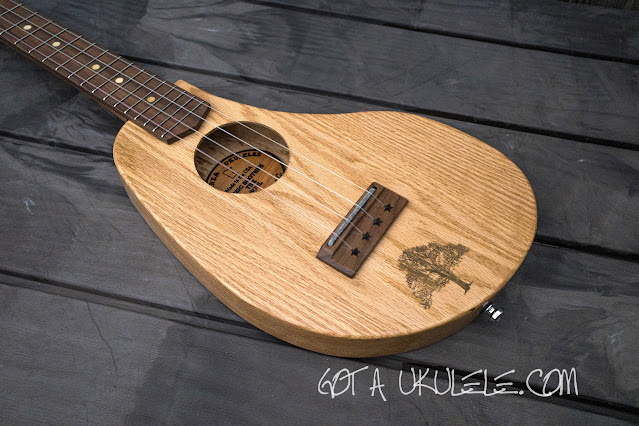
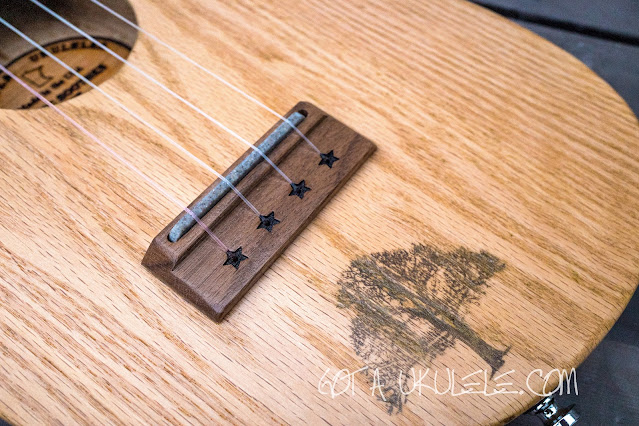

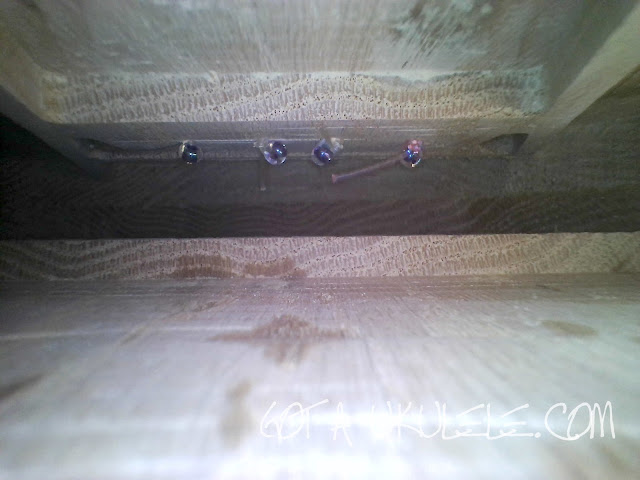
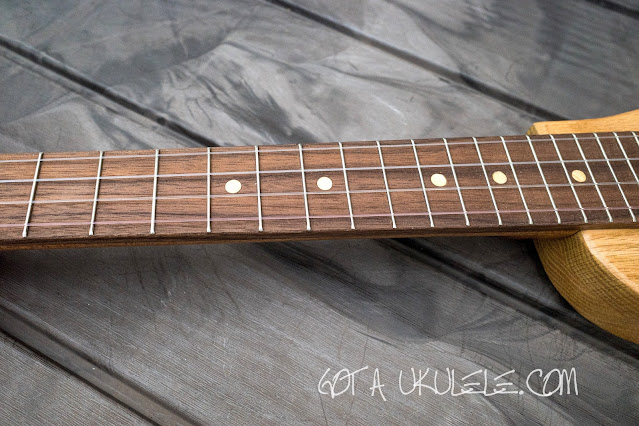


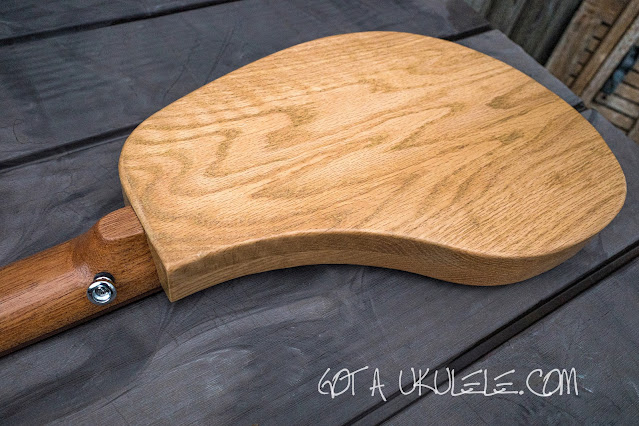
Really do like the look of the oak, and also the nicely shaped fretboard end - I notice on the Bonanza website that curved fretboard ends are also a feature - wish more makers would be a bit more creative with that. Agree about the shape, I'd go for a gently curved cutaway I think.
ReplyDelete